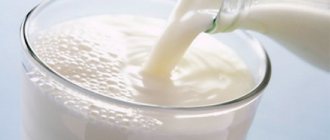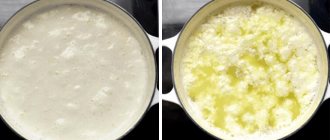Of course, virgin products are the best option. However, in everyday life it is not always possible to purchase fresh cow's milk. In such a situation, an excellent solution would be to use its powder analogue. Powdered milk retains its freshness and taste for a long time. This product can be used as an additive for tea and coffee or dissolved in water. Moreover, even this version of the product requires certain conditions, so it is important to know how to store milk powder.
How to choose
Only high-quality powdered milk can be stored for a long time. Therefore, it is important to choose it correctly:
- it is important to inspect the contents of the package, it should be crumbly, without lumps, and have a uniform structure;
- The composition should contain only natural ingredients, without preservatives.
During 2-3 months of storage in a warm place, the product may become sticky after opening. Powdered milk can be stored for up to a year in a cool place at temperatures up to +10 degrees. After this period, fat oxidation begins in the dry mixture, and it acquires an unpleasant aftertaste.
Milk can be whole or skim. By shade it is divided into white and cream. However, in any case, it must consist of homogeneous particles. Foreign inclusions with a yellowish or brownish tint indicate a violation of the product manufacturing technology.
It happens that milk powder has an off-taste. This indicates the use of low-quality raw materials or the use of vegetable fats. If the milk has a bitter aftertaste, it means that it was transported or stored at improper temperatures. Or the reason may be that the product has expired. There is no point in buying such powdered milk.
The solubility of the product can only be checked after purchase. However, this indicator also matters. Rapid dissolution, color retention and absence of sediment indicate the high quality of the product. The product is not packaged only in a cardboard box. In addition, the milk must be sealed in a bag that does not allow light and moisture to pass through.
How to check quality in the store and at home
To choose a quality product, you need to know what to look for. The following criteria will be important:
- Compound. It should not contain fatty components of plant origin and any preservatives. The composition must contain exclusively cow's milk.
- Color. A cream or pure white shade is allowed. A violation of the manufacturing process is indicated by the presence of brown, yellowish inclusions.
- Consistency. The powder should be homogeneous and crumbly. Any inclusions are not allowed.
- Taste. A good product has a pleasant caramel taste. There should be no off-flavors. The appearance of bitterness indicates a delay.
- Solubility. High-quality powder does not produce sediment when diluted with liquid. The presence of undissolved particles is a characteristic sign of poor quality SM.
The box must be intact and undamaged, and the powder must be in a tightly sealed bag.
It is important to know!
After expiration of the shelf life, the product must be disposed of. It should not be used for preparing a drink or for other purposes.
Shelf life of milk powder
- The skim milk product retains its properties even after 3 years. The main requirement is that it must remain at a temperature of +10 degrees and a humidity not higher than 85%. In addition, the powder must be in a tightly sealed container.
- Whole milk powder will keep refrigerated for up to 8 months.
- If the temperature is not higher than 20 degrees and the humidity does not exceed acceptable values, then the product can be stored for up to 3 months.
- Formula for children containing powdered milk can be stored for 6 to 12 months, at a temperature range of 1 to 10 degrees.
- Unnatural powdered milk, which contains preservatives, stabilizers, and flavorings, can be stored for more than 5 years.
Of course, the fact that such a product can be preserved much longer than usual is a plus. Before opening, it can be stored without refrigeration.
What is the powdered product?
Powdered milk is produced in a wide range by various manufacturers. At its core, the product is a concentrate that is obtained from a regular pasteurized drink.
This form of milk has many advantages:
- long shelf life;
- ease of transportation;
- compact packaging;
- preservation of all useful substances in the composition;
- opportunity to always have at hand.
The process of producing milk powder industrially includes several stages:
- Normalization, in which fat content is brought to the required level.
- Pasteurization - heating and subsequent cooling.
- Cooking/thickening.
- Homogenization – obtaining a substance that is homogeneous in composition.
- Drying using a special apparatus, resulting in the appearance of powder.
Powdered milk can be used in the diet of not only adults, but also children.
The video will show you how milk powder is produced:
Regulatory Requirements
Expiration and storage dates are indicated on packaged products. Not everyone knows that these are different terms. Since the expiration date implies a period of time after which the product is not consumed. Even if all storage standards were observed. That is, following this period guarantees that the product will not harm health if it was stored correctly.
The shelf life, in turn, states that during this time period the product will retain its quality, but not after its completion. Storage may extend beyond the expiration date. Or they will be equal.
According to GOST, the manufacturer is obliged to determine storage conditions and the time period during which the product will be suitable for consumption.
Marking deadlines
Based on the requirements of GOST R 51074, the following information is applied to the powder packaging:
- about the composition of the product;
- its nutritional value, etc.;
- including the expiration date.
Since this product is included in the list of Decree No. 720, its use is prohibited if this suitability information is not indicated.
GOST R 51074 (clause 3.5.9) states that for food products that require certain temperature conditions, as well as air humidity, it is necessary to indicate storage conditions on consumer packaging. In addition, since this product is classified as canned milk, the manufacturer may indicate the conditions under which the formula should be stored after opening the package.
How long is the shelf life of milk powder according to GOST and what does it depend on?
The product can be whole and low-fat. The former has a shorter shelf life due to its fat content. And if it is violated, it will acquire a bitter taste. The safety of the product also depends on the packaging:
- If there is a plastic container, the temperature should be less than 10 degrees. Therefore, such milk is stored in the refrigerator;
- with cellophane or parchment packaging, temperatures up to 20 degrees and humidity up to 75% are permissible. If storage standards are violated, the product should be used within 3 months.
Modern GOSTs only indicate that such information must be prescribed by the manufacturer.
Can I use it if the date has expired?
Resolution No. 720 classifies milk powder as one of those products that cannot be used after the expiration date.
- A high-quality powder should be crumbly, without lumps.
- This is a powder with a homogeneous structure.
- Usually the powder is white, but cream is also allowed.
- If it turns yellowish or brown, then this is a signal that the milk has spoiled.
- If the temperature regime is violated, the powder develops a bitter taste.
- You can also determine whether it has deteriorated by dissolving a little of the mixture in water: a high-quality mixture will dissolve quickly and its color will not change.
Expired foods can be harmful to the body. Therefore, it is important to observe the storage conditions and expiration dates of dairy and fermented milk products - milk, yogurt, butter, ice cream, sour cream, kefir, condensed milk and cottage cheese.
Powdered milk can not only be diluted and drunk together with regular milk. This powder is an excellent component for preparing various desserts. But in order for it to last longer, it is important to observe the right conditions. It is best to store milk in the refrigerator in an airtight container. The preferred temperature is no higher than 10°C. After the expiration date has expired, it is not recommended to use the product.
Compound
Currently, whole, skim and instant milk powder is produced.
Each of them differs from each other in the percentage of proteins, fats and carbohydrates. One thing remains the same - the content of vitamins, minerals and amino acids. So, the ready-to-use product contains:
- vitamins: A, B1, B2, B9, B12, D, choline, vitamins PP, E, C.
- microelements (per 100 g of milk powder): calcium - 1000 mg, sodium - 400 mg, potassium -1200 mg and phosphorus - 780 mg.
What to do if the milk has gone bad
Don't be upset if you miss the deadline. Natural milk can be processed into kefir or yogurt. To do this, you need to buy a special starter and mix it with the heated sour product.
If the whey of kefir or milk begins to flake off, make cottage cheese. To do this, the liquid also needs to be heated, but not brought to a boil, so that the cottage cheese flakes are separated from the whey, and drained into a colander lined with gauze. After this, the gauze needs to be tied and hung over the sink to drain the remaining liquid.
Also, slightly sour milk and slightly expired kefir are an excellent base for pancakes.
Useful tips for breeding
Before diluting milk powder with water yourself at home, pay attention to a few useful tips:
- It is undesirable to use cold water for these purposes, since the particles will not dissolve completely, will begin to crystallize and will be strongly felt on the teeth.
- Boiling water is also not suitable for diluting powdered milk, since the product curdles in it.
- After dilution, the liquid must be allowed to stand for a while, since in this way you can achieve an optimal product, not watery and without lumps.
- It is best not to use a mixer for stirring as it creates a lot of foam in the drink.
- The dry powder is added to the water carefully and gradually.
- If you brew natural coffee at home and season it with diluted milk powder, you will get a very tasty drink.
Porridge with dry milk
A very tasty breakfast would be porridge made from milk powder. To do this, you need to take 25 g of milk powder and dilute it in one glass of warm water. This amount yields about 250 ml of a reconstituted drink with a fat content of 2.5%. As a rule, this amount is enough to prepare one serving of porridge.
To make a healthy breakfast for four people, you need to take 120 g of milk powder and 900 ml of warm water. Stir the ingredients continuously until the milk powder is completely dissolved in the water.
Storage conditions
Storage conditions for powdered milk are prescribed by the manufacturer:
- As a rule, the standard storage temperature for powdered milk is from 0 to +10 degrees;
- At the same time, air humidity should not be more than 85%.
After the package is opened, you need to store the milk powder in a cool place. Pack it in advance in a glass sealed container.
Video: yogurt - good or bad?
Read further: Yogurt poisoning (expired) - treatment methods, consequences
How to quickly recover from food poisoning - real tips and tricks
Is it harmful to consume dairy products?
How to restore intestinal microflora after poisoning: methods
Myths and facts about colds
Article rating:
( 1 ratings, average: 5.00 out of 5)
Share with friends:
When is medical attention required?
Medical assistance is required in the following cases:
- poisoning occurred in a child, pregnant woman or elderly person;
- the patient has a high body temperature, which cannot be reduced using conventional methods;
- symptoms of poisoning persist for more than three days;
- the appearance of convulsions, severe weakness, loss of consciousness.
Medical care for yogurt poisoning includes the prescription of antidiarrheal drugs, antibacterial agents, and intravenous fluid administration.
What causes milk defects?
Milk defects are caused by poor quality feed, microflora entering the milk, incorrect processing technology, violation of storage conditions and periods, and other reasons. Consistency defects are caused by the activity of certain microorganisms.
Interesting materials:
Why can’t you heat a sauna in cold weather? Why can't you start with 2? Why should you not eat expired cereals? Why can't you insulate a house from the inside? Why can't you weld reinforcement in concrete? Why can't you cook compote in an aluminum pan? Why shouldn't you throw away tires? Why can't you get out of the swamp? Why can't you blow the solution out of a pipette? Why can't you fill a full tank of gasoline?
Possible consequences
In most cases, yogurt poisoning with proper treatment goes away within two to three days. During the recovery period after yogurt poisoning, the patient may experience impaired absorption of nutrients due to an inflammatory process in the intestinal walls. To prevent this complication, it is necessary to adhere to a diet.
After vomiting stops, the patient can be given weak chicken broth with crackers, mashed potatoes with water and without adding oil, and unsweetened rice porridge. Properly organized nutrition reduces the load on the digestive system and thereby promotes a speedy recovery.
Yogurt poisoning can also cause the development of intestinal dysbiosis in the future, especially if antibacterial drugs were used during treatment. To treat this condition, eubiotics (Bifidumbacterin, Lactobacterin) or probiotics (Hilak, Linex) are used.
The most dangerous complication of yogurt poisoning is a severe disturbance of water-electrolyte balance, up to the development of hypovolemic shock, which requires emergency hospitalization of the patient.
Carbohydrates: 52.6g. (∼210.4 kcal)
Energy ratio (b|w|y): 39% | 2% | 62%
Powdered milk - powder (see.
photo), which is obtained by drying cow's milk. It was invented so that people could take this product with them on long trips and be able to enjoy it at any time, which is why it received a lot of positive reviews. This product has a caramel flavor.
The production of milk powder takes place in 2 stages: first, the milk is condensed and then dried. As a result, the product loses 85% of its volume. It is packaged in packages using inert gases, which ensures a longer shelf life.
Powdered milk contains a large amount of fat. Considering this, it is used in the recipe for making chocolate, as well as for making some candies. In general, this product is quite widely used in the food industry, as it is included in cereals, baby food, confectionery, condensed milk, yogurt, etc.
How long can dry powders be stored?
Many housewives prefer to use milk powder, and all because of the durability and ease of storage. You can take dried milk with you on a hike or travel and not be afraid that it will spoil, because you can open the package at any time and prepare a fresh product.
However, even dry milk powders have storage restrictions, failure to comply with which leads to a deterioration in taste and a decrease in the nutritional value of the finished drink.
What is the shelf life of milk powder when opened at home? This period depends on the type of powder. Whole dried milk product is stored much less than skim milk product because it has fat, which gradually becomes bitter.
It is strictly forbidden to keep good powder in the heat, as it will quickly deteriorate. If you keep dried milk at +20 °C (room temperature), it can be stored for 3 months, and if it is opened, you need to consume the product within 30 days. The powder diluted in water can be refrigerated for up to 72 hours.
To extend the shelf life of whole dairy products, after opening the package, pour the contents into airtight paper or glass containers and place them on the refrigerator shelf. Under this condition, the shelf life of whole milk powder after opening will be 7-8 months, and skim milk – 1 year.
Powdered milk is a dairy product made from natural pasteurized milk by condensing it and drying it in special drying devices. The method is quite gentle and preserves almost all the beneficial properties of the dairy product. Dried milk is widely used in the field of cooking and agriculture for feeding newborn livestock.
How to determine the freshness of kefir and fermented baked milk
Fresh kefir has a uniform consistency. Due to mixed (lactic acid and alcohol) fermentation and special fermentation with kefir grains, gas formation is possible. Natalya Klimova notes that slight swelling of the kefir package is normal.
But for ryazhenka, on the contrary, this is a sign of damage. The product is produced by fermenting baked milk with the addition of special starter cultures. Fresh fermented baked milk is absolutely homogeneous, soft creamy in color and with a pleasant melted aftertaste.
The main sign of spoilage of fermented milk products is the appearance of watery whey on top.
Beneficial features
The benefits of powdered milk are due to its composition, which is not inferior to natural milk that has undergone pasteurization. This product contains calcium, which is necessary to strengthen bone tissue.
Powdered milk also contains potassium, which has a beneficial effect on the activity of the cardiovascular system. It contains quite a lot of vitamin A, which improves visual acuity and skin condition. Given the vitamin D content, milk powder is an anti-rickets agent.
This product contains choline, which helps normalize cholesterol levels in the blood. Thanks to chlorine, you can get rid of swelling and cleanse the body.
Powdered milk is used to reconstitute milk or a milk drink, which can then be used like natural milk. In addition, creams, baked goods and other products are prepared on its basis. As mentioned earlier, it is widely used in recipes for many confectionery products.
How to determine the freshness of yogurt
Natalya Klimova explained that depending on the production method, yogurt can be liquid (drinkable) or creamy. In any case, the consistency of the fresh product should be uniform. With the tank production method (this is when the product is first fermented in a large container and then poured into containers), the protein coagulum of the product may be damaged. With thermostatic fermentation (when the starter is added to an already packaged product), the clot should be intact.
If yogurt has pieces of fruit, it should be moderately sweet and match the color and aroma of the filler.
Symptoms of poisoning
Once in the gastrointestinal tract, pathogenic microbes produce substances that are toxic to our body. These toxins significantly increase the flow of fluid into the lumen of the digestive tract, which leads to diarrhea. Once in the bloodstream, toxins cause the development of intoxication syndrome.
The first signs of yogurt poisoning appear just a few hours after eating the low-quality product. But in some cases the incubation period is longer and amounts to several days.
The disease is characterized by a rapid, acute onset. Its main symptoms are:
- loose, profuse, frequent stools;
- nausea;
- stomach ache. Usually they are cramping in nature and decrease somewhat after bowel movement;
- vomit. It is often repeated;
- fatigue, headache, lack of appetite, muscle weakness and other manifestations of intoxication;
- dry skin and mucous membranes, increased thirst, which is associated with dehydration.
Often yogurt poisoning is accompanied by an increase in body temperature, sometimes to high values (38 °C and above).
Diagnosis of the disease is carried out on the basis of a characteristic clinical picture that develops a short time after eating a fermented milk product. To identify a specific type of pathogen, a bacteriological examination of feces and vomit is carried out.
Source: depositphotos.com
First aid for poisoning
First aid for yogurt poisoning should begin from the moment the first signs of the disease appear. It should be aimed at removing pathogenic microbes and toxic products of their vital activity from the body. To do this you should:
- Carry out gastric lavage using the “restaurant” method. The patient is given two or three glasses of water with added salt to drink, after which they begin to apply pressure to the root of the tongue with a spoon or fingers. As a result, vomiting occurs, during which the remnants of the eaten infected food are removed from the stomach. This is done several times until water comes out without any admixture of food. Gastric lavage using this method can only be performed on conscious adults.
- Take a suspension of activated carbon. To prepare it, you should crush activated carbon tablets into powder (at the rate of one tablet for every ten kilograms of body weight) and mix it with a small amount of boiled water. Instead of activated carbon, it is allowed to take any other absorbents, in particular Smecta or Enterosgel.
Harm
It would seem: what could be harmful in powdered milk? But even here you can find several pitfalls that few consumers think about.
- First: powdered milk can be a strong allergen. It is dangerous for people suffering from lactose intolerance or a secondary form of allergy to dairy products. In this case, any allergic reactions are possible - from mild malaise and flatulence to swelling and anaphylactic shock.
- Second: a lot depends on the integrity of the product’s manufacturers. Very often you can find both animal and vegetable fats in its composition. Thus, the manufacturer reduces the cost of its product due to its quality and nutritional value.











